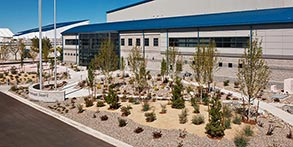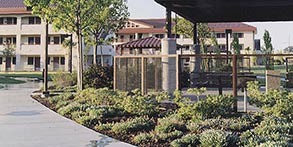- Develop, maintain and implement a climate-based plant list with landscape features using a regionally appropriate palette of materials to promote energy efficiency, preserve drainage patterns, inhibit erosion, improve air quality, lower maintenance and add beauty.
- Each base will maintain a current plant list in its Installation Facilities Standards (IFS).
- Landscaping is required for all newly developed sites and facilities; preserve existing native landscape where possible and avoid overplanting.
- Use only native, naturally occurring plant materials including grasses or turf suited for the local climatic conditions in the landscape design; potable-water irrigation systems are discouraged beyond the establishment period.
- Buildings should cost-effectively integrate a grey-water reclamation system following IFS, which provides source water for an automatic drip irrigation system; all non-xeric, adaptive plantings adjacent to facilities will be connected to a grey-water irrigation system when available and prohibit the use of potable water for landscape irrigation beyond the establishment period.
- Life cycle cost effectively equip grey-water irrigation systems to sense soil moisture, rainfall and wind to minimize unnecessary watering; incorporate drip irrigation systems as the primary source.
- Concentrate landscaping in Facility Group 1 (facilities having the highest profile) and along major thoroughfares and integrate these landscaped areas into the base’s stormwater management plan.
- All Facility Group 1 and 4 sites will be landscaped at their entire perimeter; limit formal planting arrangements to formal spaces typically associated with Group 1.
- Facility Group 2 and 3 sites may have a native undisturbed landscape except at the main entrances of Group 2.
- Facility plantings must follow the Installation Facilities Standards (IFS) plant list, which is based on the specific microclimates created by the adjacent building: shadow areas, protected areas, zones adjacent to thermal mass, and availability of rainwater and/or grey water.
- Trees should be the focus of landscape plantings and, where possible, should be a mix of deciduous and evergreen species for variety; provide tree grates when appropriate and use tree guards on smaller trees.
- Ground covers are only recommended when the local climate yields minimal maintenance requirements.
- Turfs areas should be limited to areas that can be sustained by natural rainfall or grey water (non-potable) irrigation systems; turf may be defined by at grade concrete mow strips to lessen maintenance.
- Analyze soils and provide organic amendments as needed to improve plant growth and conserve water.
- Define planting areas with walkways, edging or concrete header curbs following IFS.
- Provide planting islands within parking lots for shade and appeal following IFS and the base stormwater management plan.
- Integrate appropriate landscaping elements into parking areas to visually soften the appearance at a minimum rate of 10 percent of the total area.
- Avoid trees that drop sap, fruit, or seeds, and use long-lived species; keep trees trimmed, removing dead and dying trees or branches.
- Create public spaces near the main entrances of Group 1 facilities.
- Provide open spaces as transitions between developed and native areas that promote quality of life, provide visual relief and allow walkable connections to the transportation system.
- Return suitable areas to a natural state to minimize and, whenever possible, eliminate ground maintenance requirements; expand wooded areas where appropriate with native trees and understory plants to eliminate mowing and maintenance requirements.
- In tree clusters replace grass with naturalized shrub beds and leaf litter mulch to eliminate mowing requirements.
- Use plantings in open spaces to reinforce the space as a visual asset.
- Consider landscape windbreaks when suitable for the local climate per IFS.
- Providing landscaping as visual screening is preferred to the construction of walls and fences; berming and mounding may supplement landscape screening.
Cost effectively provide climate-based landscape features following principles of sustainable design and low impact design integrating existing context, safety, security, circulation, accessibility, functionality, cost effectiveness, and aesthetics following UFC 3-201-02. Adhere to IFS for landscape materials and irrigation and for minimum ongoing maintenance requirements.
Sustainability
Use water-efficient regionally appropriate landscape and irrigation strategies, such as water reuse and the use of harvested rainwater, following UFC 1-200-02. Comply with DoD Memorandum, “Water Use for Landscape Architecture on Department of Defense Installations / Sites”, with strategies to meet the requirement for no potable water irrigation. Cost-effectively integrate grey-water irrigation systems following IFS. Coordinate landscape with other site features and building elements to promote efficiencies in passive systems such as shading.
Resilience
Consider the documented risks from weather, climate and geological events and develop landscape designs that have minimal impact on mission operations following these events.
In areas subject to storm surge or flooding, develop a resilient landscape with appropriate materials that recover with minimal required maintenance.
UFC 1-200-02 High Performance and Sustainable Building Requirements https://www.wbdg.org/dod/ufc/ufc-1-200-02
UFC 3-201-02 Landscape Architecture https://www.wbdg.org/dod/ufc/ufc-3-201-02
DoD Memorandum, "Water Use for Landscape Architecture on Department of Defense Installations / Sites", 10 March 2017 https://www.acq.osd.mil/eie/Downloads/IE/Water%20Use%20for%20Landscape%20Architecture%203.10.17.pdf








